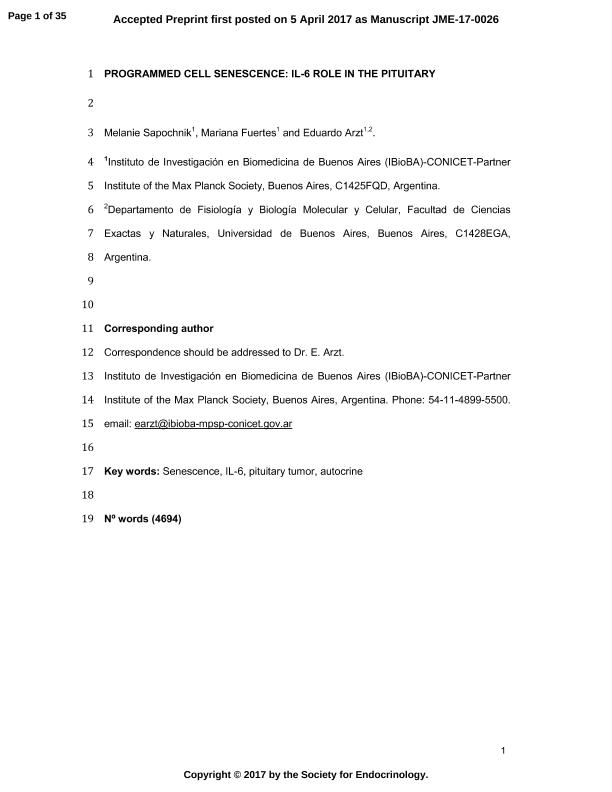Mostrar el registro sencillo del ítem
dc.contributor.author
Sapochnik, Melanie Denise

dc.contributor.author
Fuertes, Mariana

dc.contributor.author
Arzt, Eduardo Simon

dc.date.available
2018-09-12T14:50:23Z
dc.date.issued
2017-05
dc.identifier.citation
Sapochnik, Melanie Denise; Fuertes, Mariana; Arzt, Eduardo Simon; Programmed cell senescence: Role of IL-6 in the pituitary; BioScientifica; Journal of Molecular Endocrinology; 58; 4; 5-2017; R241-R253
dc.identifier.issn
0952-5041
dc.identifier.uri
http://hdl.handle.net/11336/59279
dc.description.abstract
IL-6 is a pleiotropic cytokine with multiple pathophysiological functions. As a key factor of the senescence secretome, it can not only promote tumorigenesis and cell proliferation but also exert tumor suppressive functions, depending on the cellular context. IL-6, as do other cytokines, plays important roles in the function, growth and neuroendocrine responses of the anterior pituitary gland. The multiple actions of IL-6 on normal and adenomatous pituitary function, cell proliferation, angiogenesis and extracellular matrix remodeling indicate its importance in the regulation of the anterior pituitary. Pituitary tumors are mostly benign adenomas with low mitotic index and rarely became malignant. Premature senescence occurs in slow-growing benign tumors, like pituitary adenomas. The dual role of IL-6 in senescence and tumorigenesis is well represented in pituitary tumor development, as it has been demonstrated that effects of paracrine IL-6 may allow initial pituitary cell growth, whereas autocrine IL-6 in the same tumor triggers senescence and restrains aggressive growth and malignant transformation. IL-6 is instrumental in promotion and maintenance of the senescence program in pituitary adenomas.
dc.format
application/pdf
dc.language.iso
eng
dc.publisher
BioScientifica

dc.rights
info:eu-repo/semantics/openAccess
dc.rights.uri
https://creativecommons.org/licenses/by-nc-sa/2.5/ar/
dc.subject
Autocrine
dc.subject
Il-6
dc.subject
Pituitary Tumor
dc.subject
Senescence
dc.subject.classification
Otras Medicina Básica

dc.subject.classification
Medicina Básica

dc.subject.classification
CIENCIAS MÉDICAS Y DE LA SALUD

dc.title
Programmed cell senescence: Role of IL-6 in the pituitary
dc.type
info:eu-repo/semantics/article
dc.type
info:ar-repo/semantics/artículo
dc.type
info:eu-repo/semantics/publishedVersion
dc.date.updated
2018-09-11T14:46:00Z
dc.identifier.eissn
1749-6813
dc.journal.volume
58
dc.journal.number
4
dc.journal.pagination
R241-R253
dc.journal.pais
Reino Unido

dc.journal.ciudad
Bristol
dc.description.fil
Fil: Sapochnik, Melanie Denise. Consejo Nacional de Investigaciones Científicas y Técnicas. Oficina de Coordinación Administrativa Parque Centenario. Instituto de Investigación en Biomedicina de Buenos Aires - Instituto Partner de la Sociedad Max Planck; Argentina
dc.description.fil
Fil: Fuertes, Mariana. Consejo Nacional de Investigaciones Científicas y Técnicas. Oficina de Coordinación Administrativa Parque Centenario. Instituto de Investigación en Biomedicina de Buenos Aires - Instituto Partner de la Sociedad Max Planck; Argentina
dc.description.fil
Fil: Arzt, Eduardo Simon. Consejo Nacional de Investigaciones Científicas y Técnicas. Oficina de Coordinación Administrativa Parque Centenario. Instituto de Investigación en Biomedicina de Buenos Aires - Instituto Partner de la Sociedad Max Planck; Argentina
dc.journal.title
Journal of Molecular Endocrinology

dc.relation.alternativeid
info:eu-repo/semantics/altIdentifier/doi/http://dx.doi.org/10.1530/JME-17-0026
dc.relation.alternativeid
info:eu-repo/semantics/altIdentifier/url/https://jme.bioscientifica.com/view/journals/jme/58/4/R241.xml
Archivos asociados
